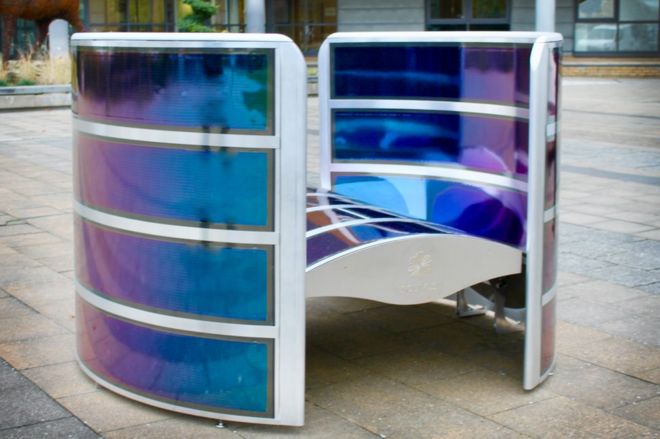IT CAN HAPPEN HERE
It’s possible that I shall make an ass of myself. But in that case one can always get out of it with a little dialectic. I have, of course, so worded my proposition as to be right either way (K.Marx, Letter to F.Engels on the Indian Mutiny)
Tuesday, January 21, 2020
Behind the blitz: Falun Gong practitioners spend millions on Shen Yun ads. How do they do it?
Matthias Gafni Jan. 11, 2020

Matthias Gafni Jan. 11, 2020

1of5
A man walks near a Shen Yun billboard as he approaches
Park Blvd. and East 20th Street, in Oakland, Calif., on
Tuesday, January 7, 2020.
Photo: Yalonda M. James, The Chronicle


2of5
A Shen Yun ad and poster are seen on the outside of the
San Jose Center for the Performing Arts on Tuesday,
January 7, 2020 in San Jose, Calif.Photo: Lea Suzuki,
The Chronicle

A smiling young woman flying through the air, her legs splayed at a perfect 180 degrees as she reaches her arms skyward, unveiling a nearly full circle of white fabric
It’s “Shen Yun” season and if your heart circulates blood you’ve seen an advertisement promising “5,000 years of civilization reborn.” In the Bay Area and across many parts of the world, Shen Yun ads are as ubiquitous as 1-877-Kars4Kids radio jingles as they encourage people to shell out for tickets to see the dance troupe and symphony that — to the surprise of some viewers — promote the spiritual movement called Falun Gong, also known as Falun Dafa.
If it seems practitioners of Falun Gong, which is locked in a bitter political battle with the communist government of China, spend a lot on publicity for the show, well, they do.
Shen Yun-linked nonprofit groups spent at least $39.3 million on advertising across the country from 2015 to 2017, according to a Chronicle review of three years of federal tax returns, the most recent made public. It’s possible the spending has gone up since, and that the records analyzed do not account for all of the spending on publicity for Shen Yun.
Over those three years, Shen Yun Performing Arts Inc., based in Cuddebackville, N.Y., reported revenue of $72.8 million, largely from ticket sales for shows performed in various cities by one of the dance company’s traveling troupes. The outfit just finished up a run of shows in San Francisco and has upcoming performances in San Jose, Berkeley, Modesto and Fresno.
Shen Yun Performing Arts spent $47.2 million in those three years, according to tax returns, putting on its shows that accuse the Chinese Communist party of persecuting Falun Gong adherents. That has helped the nonprofit boost its assets from $61 million to $95.7 million by the end of 2017.
In San Francisco and the Bay Area, the shows are run by the San Francisco Falun Buddha Study Association, which lists as its mission: “Foster the universal principles and values of ‘truthful, compassion and tolerant’ through various forms including Falun Dafa (Falun Gong) studies, exercises and experience-sharing activities.”

A Shen Yun billboard in the 900 block of Mission St. in
Matthias Gafni joined The San Francisco Chronicle as an enterprise reporter in February 2019. He investigates stories in the East Bay and beyond. For almost two decades, Gafni worked for the Bay Area News Group – San Jose Mercury News, East Bay Times and Vallejo Times-Herald -- covering corruption, child sexual abuse, criminal justice, aviation and more. He was born and raised in the Bay Area and graduated from UC Davis. He lives with his wife and three kids in the East Bay.

3of5Shen Yun advertisement at 6th and Folsom in San Francisco,
Calif., on Tuesday, January 7, 2020.
Photo: Scott Strazzante, The Chronicle
The image is likely hanging on your doorknob as you read this. And popping up on your Facebook feed. When you glance up from your phone, there it is again — on a billboard, a bus or the wall of a BART platform
The image is likely hanging on your doorknob as you read this. And popping up on your Facebook feed. When you glance up from your phone, there it is again — on a billboard, a bus or the wall of a BART platform
A smiling young woman flying through the air, her legs splayed at a perfect 180 degrees as she reaches her arms skyward, unveiling a nearly full circle of white fabric
It’s “Shen Yun” season and if your heart circulates blood you’ve seen an advertisement promising “5,000 years of civilization reborn.” In the Bay Area and across many parts of the world, Shen Yun ads are as ubiquitous as 1-877-Kars4Kids radio jingles as they encourage people to shell out for tickets to see the dance troupe and symphony that — to the surprise of some viewers — promote the spiritual movement called Falun Gong, also known as Falun Dafa.
If it seems practitioners of Falun Gong, which is locked in a bitter political battle with the communist government of China, spend a lot on publicity for the show, well, they do.
Shen Yun-linked nonprofit groups spent at least $39.3 million on advertising across the country from 2015 to 2017, according to a Chronicle review of three years of federal tax returns, the most recent made public. It’s possible the spending has gone up since, and that the records analyzed do not account for all of the spending on publicity for Shen Yun.
Over those three years, Shen Yun Performing Arts Inc., based in Cuddebackville, N.Y., reported revenue of $72.8 million, largely from ticket sales for shows performed in various cities by one of the dance company’s traveling troupes. The outfit just finished up a run of shows in San Francisco and has upcoming performances in San Jose, Berkeley, Modesto and Fresno.
Shen Yun Performing Arts spent $47.2 million in those three years, according to tax returns, putting on its shows that accuse the Chinese Communist party of persecuting Falun Gong adherents. That has helped the nonprofit boost its assets from $61 million to $95.7 million by the end of 2017.
In San Francisco and the Bay Area, the shows are run by the San Francisco Falun Buddha Study Association, which lists as its mission: “Foster the universal principles and values of ‘truthful, compassion and tolerant’ through various forms including Falun Dafa (Falun Gong) studies, exercises and experience-sharing activities.”
Such nonprofit organizations are required by law to release their tax returns. The Chronicle’s review of ad spending looked at more than 30 groups, most of whom posted three years of records. Shen Yun Performing Arts itself spends no money on advertising, instead relying on the smaller Falun Dafa nonprofits, based out of regions across the country, to promote the shows in their areas.
In 2017, the San Francisco nonprofit group reported $3.9 million in ticket sales, while spending $2.2 million on advertising and promotion.
In general, spending such a high percentage of expected revenue on marketing “just defies logic,” said Bill Pearce, assistant dean of UC Berkeley’s Haas School of Business and its chief marketing officer.
“Typically, if you’re higher than 10% it’s really high,” he said, noting that the industry benchmark for ad spending is 7.5% of projected revenue. “It’s truly from a marketing standpoint what we call a ‘heavy-up.’ ”
Shen Yun’s finances seem to pencil out, Pearce said, thanks to the work of volunteers. The San Francisco Falun Gong group reported having 100 volunteers, while the international theater company had another 211, according to the 2017 tax returns. Each regional nonprofit operates on a completely volunteer workforce.
The theater company reported paying 192 employees a total of $5.9 million in 2017, meaning dancers and other paid workers made less than $30,000 on average.
A Shen Yun ad is seen on the side of a bus traveling down
In 2017, the San Francisco nonprofit group reported $3.9 million in ticket sales, while spending $2.2 million on advertising and promotion.

In general, spending such a high percentage of expected revenue on marketing “just defies logic,” said Bill Pearce, assistant dean of UC Berkeley’s Haas School of Business and its chief marketing officer.
“Typically, if you’re higher than 10% it’s really high,” he said, noting that the industry benchmark for ad spending is 7.5% of projected revenue. “It’s truly from a marketing standpoint what we call a ‘heavy-up.’ ”
Shen Yun’s finances seem to pencil out, Pearce said, thanks to the work of volunteers. The San Francisco Falun Gong group reported having 100 volunteers, while the international theater company had another 211, according to the 2017 tax returns. Each regional nonprofit operates on a completely volunteer workforce.
The theater company reported paying 192 employees a total of $5.9 million in 2017, meaning dancers and other paid workers made less than $30,000 on average.

A Shen Yun ad is seen on the side of a bus traveling down
Santa Clara Street on Tuesday, January 7, 2020 in San Jose,
Calif. Photo: Lea Suzuki, The Chronicle
Another financial benefit: Falun Gong is linked to the Epoch Times and Epoch Media Group, news organizations founded by practitioners that provide an outlet to handle printing, direct mail and other marketing needs for Shen Yun, according to tax returns.
The Epoch Times, which in recent years has been criticized for supporting far-right conspiracy theories, prominently features stories about Shen Yun. An article on the website dated Friday carried the headline, “Corporate Leaders Applaud Shen Yun’s Beautiful Stories of Integrity.”
Officials at Shen Yun Performing Arts headquarters did not respond to a request for comment, but one of the volunteers at the San Francisco nonprofit spoke to The Chronicle.
David Zhang, a software engineer who has practiced Falun Gong for 16 years, helps promote performances in the Bay Area. The mass advertising is only possible because he and other followers give their time, Zhang said, emphasizing he spoke for himself and not the entire nonprofit.
“I don’t dance or sing, I just do my best to help and do it from the bottom of my heart,” he said. “We’re facing an incredible challenge and we want to get the word out. We’re facing incredible repression.”
Shen Yun was formed in 2006 by followers of Falun Gong, which Li Hongzhi had founded in China in 1992 and drew on the tradition of qigong, in which breathing, meditation and movement foster good health or spiritual enlightenment.
Li drew attention for voicing strange beliefs, including saying in a 1999 interview with Time magazine that “aliens have begun to invade the human mind and its ideology and culture.” But Falun Gong has fought allegations that it is a cult from Chinese authorities, and journalists and researchers who have written about the movement say it has no record of using abuse or coercion.
The Chinese government banned Falun Gong in 1999, and in recent years the embassy in the U.S. has not shied from striking against Shen Yun — and its organizers.
Before the show started at a Dec. 20, 2019 performance
Another financial benefit: Falun Gong is linked to the Epoch Times and Epoch Media Group, news organizations founded by practitioners that provide an outlet to handle printing, direct mail and other marketing needs for Shen Yun, according to tax returns.
The Epoch Times, which in recent years has been criticized for supporting far-right conspiracy theories, prominently features stories about Shen Yun. An article on the website dated Friday carried the headline, “Corporate Leaders Applaud Shen Yun’s Beautiful Stories of Integrity.”
Officials at Shen Yun Performing Arts headquarters did not respond to a request for comment, but one of the volunteers at the San Francisco nonprofit spoke to The Chronicle.
David Zhang, a software engineer who has practiced Falun Gong for 16 years, helps promote performances in the Bay Area. The mass advertising is only possible because he and other followers give their time, Zhang said, emphasizing he spoke for himself and not the entire nonprofit.
“I don’t dance or sing, I just do my best to help and do it from the bottom of my heart,” he said. “We’re facing an incredible challenge and we want to get the word out. We’re facing incredible repression.”
Shen Yun was formed in 2006 by followers of Falun Gong, which Li Hongzhi had founded in China in 1992 and drew on the tradition of qigong, in which breathing, meditation and movement foster good health or spiritual enlightenment.
Li drew attention for voicing strange beliefs, including saying in a 1999 interview with Time magazine that “aliens have begun to invade the human mind and its ideology and culture.” But Falun Gong has fought allegations that it is a cult from Chinese authorities, and journalists and researchers who have written about the movement say it has no record of using abuse or coercion.
The Chinese government banned Falun Gong in 1999, and in recent years the embassy in the U.S. has not shied from striking against Shen Yun — and its organizers.

Before the show started at a Dec. 20, 2019 performance
of Shen Yun at Zellerbach Hall in Berkeley.
Photo: Alix Martichoux, SFGATE
“Clearly, the so-called ‘Shen Yun’ is not a cultural performance at all but a political tool of ‘Falun Gong’ to preach cult messages, spread anti-China propaganda, increase its own influence and raise fund(s),” the embassy states on its website. “(The) show denigrates and distorts the Chinese culture, and deceives, makes fool of and even brings harm to the audience.”
On its own website, Shen Yun leaders state, “While Falun Dafa practitioners in China continue to face horrific abuse, the Party has been extending its persecution outside of China. This includes harassing Shen Yun.”
Shen Yun means the “beauty of divine beings dancing,” and has six companies touring the world, claiming to perform in more than 150 theaters every year.
The show is a “soft approach in trying to interest people in their practices and win people over,” said David Bachman, an international studies professor at the University of Washington who specializes in Chinese politics. He said he often sees students handing out Shen Yun fliers on campus.
In a particularly detailed tax return, the Greater Philadelphia Falun Dafa Association offered a peek inside its operation of 55 volunteers. In 2017, Shen Yun put on 23 shows in Philadelphia and Pittsburgh, gaining almost 31,000 attendees and almost $2.8 million in ticket sales.
The group spent $1.4 million in advertising that year, paying an Illinois company $500,000 for direct mailing and a Dallas television station $200,000 for ads. It also paid $320,000 to two companies linked to Falun Gong for direct mailing and online ads, according to its tax return.
Photo: Alix Martichoux, SFGATE
“Clearly, the so-called ‘Shen Yun’ is not a cultural performance at all but a political tool of ‘Falun Gong’ to preach cult messages, spread anti-China propaganda, increase its own influence and raise fund(s),” the embassy states on its website. “(The) show denigrates and distorts the Chinese culture, and deceives, makes fool of and even brings harm to the audience.”
On its own website, Shen Yun leaders state, “While Falun Dafa practitioners in China continue to face horrific abuse, the Party has been extending its persecution outside of China. This includes harassing Shen Yun.”
Shen Yun means the “beauty of divine beings dancing,” and has six companies touring the world, claiming to perform in more than 150 theaters every year.
The show is a “soft approach in trying to interest people in their practices and win people over,” said David Bachman, an international studies professor at the University of Washington who specializes in Chinese politics. He said he often sees students handing out Shen Yun fliers on campus.
In a particularly detailed tax return, the Greater Philadelphia Falun Dafa Association offered a peek inside its operation of 55 volunteers. In 2017, Shen Yun put on 23 shows in Philadelphia and Pittsburgh, gaining almost 31,000 attendees and almost $2.8 million in ticket sales.
The group spent $1.4 million in advertising that year, paying an Illinois company $500,000 for direct mailing and a Dallas television station $200,000 for ads. It also paid $320,000 to two companies linked to Falun Gong for direct mailing and online ads, according to its tax return.

A Shen Yun billboard in the 900 block of Mission St. in
San Francisco, Calif., on Tuesday, January 7, 2020.
Photo: Yalonda M. James, The Chronicle
Pearce, the Berkeley marketer, called the advertising blitz “omnipresent,” an approach that can backfire.
“There’s always a risk that if your message is seen too many times consumers will tune it out,” he said. “I think you can go past building a brand and you start building a meme.”
Zhang said that while volunteers are not marketing experts, they feel the publicity is effective.
“It’s working good. It’s getting a lot of people to the performances. Most of the shows sold out,” Zhang said. “That’s the goal of marketing. It’s not necessarily a bad thing.”
Matthias Gafni is a San Francisco Chronicle staff writer. Email: matthias.gafni@sfchronicle.com Twitter: @mgafni

Matthias Gafni
Follow Matthias on:https://www.facebook.com/SFChronicle/mgafni
Photo: Yalonda M. James, The Chronicle
Pearce, the Berkeley marketer, called the advertising blitz “omnipresent,” an approach that can backfire.
“There’s always a risk that if your message is seen too many times consumers will tune it out,” he said. “I think you can go past building a brand and you start building a meme.”
Zhang said that while volunteers are not marketing experts, they feel the publicity is effective.
“It’s working good. It’s getting a lot of people to the performances. Most of the shows sold out,” Zhang said. “That’s the goal of marketing. It’s not necessarily a bad thing.”
Matthias Gafni is a San Francisco Chronicle staff writer. Email: matthias.gafni@sfchronicle.com Twitter: @mgafni

Matthias Gafni
Follow Matthias on:https://www.facebook.com/SFChronicle/mgafni
Matthias Gafni joined The San Francisco Chronicle as an enterprise reporter in February 2019. He investigates stories in the East Bay and beyond. For almost two decades, Gafni worked for the Bay Area News Group – San Jose Mercury News, East Bay Times and Vallejo Times-Herald -- covering corruption, child sexual abuse, criminal justice, aviation and more. He was born and raised in the Bay Area and graduated from UC Davis. He lives with his wife and three kids in the East Bay.
TRUMP SUPPORTER WHO DISCUSSED SURVEILLANCE OF AMBASSADOR MARIE YOVANOVITCH HAS HISTORY OF STALKING, MENTAL HEALTH ISSUES
Lee Fang
January 15 2020
THE MAN who relayed information about Ambassador Marie Yovanovitch’s location to Rudy Giuliani’s Ukrainian associates was a known stalker with mental health issues.
Newly released private WhatsApp messages between Lev Parnas, an associate of Giuliani’s, and Robert F. Hyde, a donor to President Donald Trump’s campaign and aspiring GOP lawmaker, reveal what appears to be an effort to surveil the former ambassador to Ukraine, whose ouster was sought by Giuliani as part of a plan to pressure the Ukrainian government into pursuing political investigations at the White House’s behest.
The messages, released Tuesday by the House Intelligence Committee relating to its ongoing impeachment inquiry, show Hyde claiming to know Yovanovitch’s location and movements in Kyiv, while implying that he was in contact with local security services in Ukraine who could be paid to go after the ambassador.
The startling messages show the extent to which the Giuliani associates were willing to at least entertain extreme tactics from a campaign donor who has courted controversy and even unsettled others, including fellow supporters of the president.
The Intercept obtained police records showing that Hyde violated a restraining order issued by a Washington, D.C., Superior Court judge at the request of a Republican consultant who says that Hyde stalked her and intimidated her family over the last year. In one of the reports, an officer disclosed that Connecticut police confiscated Hyde’s firearms in connection to his violation of the restraining order. Hyde was reported to authorities for “unsettling behavior” and trespassing at a church in Connecticut, according to a separate police report last summer.
Asked for comment, Hyde texted The Intercept, “Bull Schiff is still crying?! Lol. Tell him to go whistleblow himself.” He did not respond to other allegations against him.
Hyde’s other acquaintances noted that he has a history of erratic behavior. Jeffrey Peterson, a technology entrepreneur, said Hyde came to meet with him recently, then disappeared, only to resurface months later. Hyde, Peterson said, “has been trying to reestablish contact with me ever since, not really comfortable with him.”
Hyde publicized that he was placed in a psychiatric facility in Florida last May, following an incident at the Trump National Doral Miami resort. A report written by the Doral Police Department at the time notes that Hyde expressed fear for his life and told officers that he “was scared due to several painting workers and landscape working trying to do harm to him because they weren’t working.”
Hyde posted about his facility stay in a now-deleted Instagram video. “I don’t know what that nine days was in that facility, and they wanted to keep me 10 and I finally got out, but here I am,” Hyde said in the video following his release. The caption for the video and the police report reference confinement under Florida’s Baker Act, which allows individuals showing signs of mental illness who could pose a danger to themselves or others to be involuntarily submitted to a mental health facility.
Shortly after his release, in a now-deleted Facebook post, Hyde wondered if Dan Coats, Trump’s former Director of National Intelligence, “effed with me in DC a month ago” and “probably initiated my disappearance for awhile.”
Last year, Hyde began a campaign for Congress, seeking the Republican nomination to challenge Rep. Jahana Hayes, D-Conn. The former owner of a landscaping company, Hyde describes himself as a “U.S. Marine Corps Iraqi Freedom war veteran” and “an ardent support of our duly elected president, President Trump” on his campaign website.
Hyde has other legal issues, according to records, including an eviction from a commercial property in Simsbury, Connecticut, where his former business was located. In 2011, Hyde was arrested in Avon, Connecticut, for reckless endangerment in connection a tree that fell on power lines near one of his work sites. He also owes more than $2,000 in child support payments, according to the Hartford Courant, despite donating thousands of dollars to Trump and the Republican National Committee.
Hyde’s tone toward women has also sparked a minor scandal in his political campaign. In December, after Sen. Kamala Harris, D-Calif., suspended her presidential bid, Hyde tweeted that Harris was “brought to her knees,” followed by the message: “Must be a hard one to swallow. #KamalaHarris #heelsup.” The inflammatory message was swiftly condemned by both parties. The Connecticut Republican Party returned Hyde’s donation of $750 in response to his “vile comments on Twitter.”
In the newly released WhatsApp messages, Hyde wrote to Parnas, “Wow. Can’t believe Trumo [sic] hasn’t fired this bitch,” in reference to Yovanovitch.
Throughout 2018 and much of early 2019, Parnas and his business partner, Igor Fruman, worked closely with Giuliani to oust Yovanovitch, a career diplomat who was viewed as an obstacle to a plot to use the Ukrainian government to investigate Trump’s political adversaries, including former Vice President Joe Biden, his son Hunter, and the Democratic National Committee.
As part of the effort, Parnas and Fruman committed to raising $20,000 for then-Rep. Pete Sessions, R-Texas, in exchange for a letter from Sessions to the State Department demanding Yovanovitch’s ouster.
The WhatsApp messages between Hyde and Parnas reveal a new dimension to the continued focus of Giuliani’s focus on Yovanovitch. “She under heavy protection outside Kiev,” Hyde wrote to Parnas last March. In another batch of messages, Hyde claimed, “That address I sent you checks out. It’s next to the embassy.” Other Hyde messages conveyed an eerie level of knowledge about Yovanovitch’s activities: “She’s talked to three people. Her phone is off. Computer is off. She’s next to the embassy. Not in the embassy. Private security. Been there since Thursday.”
Parnas’s lawyer, Joseph A. Bondy, did not immediately respond to request from The Intercept. In a statement to the Washington Post, he said, “There is no evidence that Mr. Parnas participated, agreed, paid money or took any other steps in furtherance of Mr. Hyde’s proposals.”
Hyde also sent several cryptic messages that implied he knew of “security forces” in Ukraine who could be tapped for assistance. “They are willing to help if we/you would like a price. Guess you can do anything in Ukraine with money …” Parnas responded, “Lol.”
Whether Hyde truly had special access to Yovanovitch remains unclear. The WhatsApp messages were sent last March as the Giuliani-backed campaign to force Ukraine to investigate the Bidens escalated. In April, Trump ordered Yovanovitch to be recalled to Washington, and she was terminated from her post in early May. In November, during the impeachment hearing, Yovanovitch testified that she had been advised by the State Department that she faced threats to her security last year.
Hyde’s various social media profiles are filled with pictures of him with the president, Eric Trump, Corey Lewandowski, Roger Stone, Sarah Sanders, and a variety of Republican lawmakers. On multiple occasions, his photo has been snapped at federal government offices and at Trump-owned properties in New Jersey, Florida, and Washington, D.C. As CNN reported, Hyde “posed for a selfie with Trump on Easter Sunday, April 21, 2019, the same day Trump first called Ukraine President Volodymyr Zelensky.”
Last year, Hyde texted photos to Emilie Munson, a Connecticut-based journalist, including images of himself smoking cigars with Giuliani, Fruman, and Parnas.
I stand with @realDonaldTrump! pic.twitter.com/lKLTYZAfIy— HYDE for U.S. Congress (@rfhyde1) January 3, 2020
---30---
Climate change: Citizens' assembly prepares to tackle climate change
By Roger HarrabinBBC environment analyst
 Image copyrightAFP
Image copyrightAFP
Should aviation be taxed more? Should SUVs be banned? Should wind power be subsidised by taxpayers?
These are the sort of the climate-related questions to be pondered by a new "citizens' assembly", composed of 110 members of the public.
The panel has been selected to reflect key sectors of society and a range of opinion.
They will spend four weekends listening to evidence from experts on how climate policy and science will affect the UK.
Then they’ll offer their opinions on the best ways for Britain to achieve its demanding law that mandates "net zero" carbon emissions by 2050.
Net zero describes achieving an overall balance between the emissions produced and emissions removed from the atmosphere.
What's the reasoning behind it?
The idea for this unprecedented assembly was conceived by MPs on six parliamentary select committees who want to learn more about the public's opinions on climate change.
It will solely offer advice for the UK to meet its own Climate Change Act.
It will not debate the scientific consensus that climate change is dangerous.
Nor will it debate if the net zero target should be brought forward to 2030, as the Extinction Rebellion group has called for.
What will the jury members do?
Some 30,000 invitations to take part were sent out under a process designed to represent all parts of the UK and differences in race, gender, age and views on climate change. People from both rural and urban areas were selected.
Thousands agreed to take part, then these were whittled down to 110.
The gathering will include views of all hues – from people who don’t fear climate change to those who definitely do.
 Image copyrightREUTERS
Image copyrightREUTERS
Most of the presentations they experience will come from academics, although think-tanks, NGOs, and industry voices will also be heard.
On food, for instance, the assembly will hear opposing views from the National Farmers Union and from the Royal Society of Arts and Commerce, which argues for the need to change the way we farm.
The project’s being organised by a charity, Involve. It pledges to “uphold key principles of balance, accuracy and comprehensiveness”.
What will be the outcome?
The assembly’s website says the members of its advisory panel were chosen to represent a broad range of views across different sectors. All the expert advisers are acting voluntarily.
Sarah Allan from Involve told BBC News: "The aim is to give people a say on how the UK tackles climate change, and to give parliament and the government an understanding of what people think and where priorities lie.
“The focus is on how the UK achieves net zero. We will get people to look at trade-offs. They can’t say: 'we want net zero' then vote for doing nothing about it.'
She continued: “The Irish assembly was an incredibly useful tool for decision-makers – we are very optimistic that the UK climate change assembly will be useful too.”
One of the project’s leaders is Lorraine Whitmarsh, professor of environmental psychology at Cardiff University.
“It’s very exciting - we haven’t done anything on this level before,” she told BBC News. “It’s huge, and the recruitment (of members) has to be gold standard."
Will climate sceptics be involved?
Ms Whitmarsh explained: “There will be sceptics who don’t even believe climate change is caused by humans. But even they may want to consider evidence that some climate polices (such as active transport) will have health benefits attached.
“There will be other people who are very worried about climate change – but they may turn out to be unwilling to take on some of the financial consequences involved.
“It’s going to be really interesting.”
The announcement by the six select committees to hold a citizens assembly on climate change was in direct response to government policy on net zero carbon emissions by 2050, and was announced on 20 June 2019.
The net zero policy became law on 27 June 2019, making the UK the first major economy in the world to legislate for net zero. The 2019 Conservative party manifesto re-affirmed the government’s commitment to this target.
AMERICAN'S ARE RELIGIOUS NUTZ
JUST DON'T CALL THEM CHRISTIANS
Religious woman drove into oncoming traffic to ‘test her faith’
'Reilly also stated she did not care if the other people were injured because God would have taken care of them,' said police
Kate Ng

Route 93, where the incident occurred
A woman allegedly drove her car into oncoming traffic, hitting a car with three passengers in a bid to “test her faith”, said Pennsylvania State Police.
Nadejda Reilly, 51, was arrested on 7 January after she was involved in a head-on collision with a car on a major north-south highway in the US.
Ms Reilly had been reportedly driving for several hours waiting for a “calling from God” when she saw a car driving on the opposite side.
According to the affidavit from Pennsylvania police, she allegedly “wanted to test her faith by driving through the vehicle” and deliberately drove her car into the opposing lane of traffic.
Ms Reilly and two of the other car’s passengers were injured and taken to Lehigh Hospital-Hazleton. A third passenger was unharmed, said Trooper David Peters.
The two victims were an adult, who has been treated and released from hospital, and a 14-year-old girl whose condition is not immediately known, reported CNN.
Trooper Bruce Balliet said in the affidavit: “Reilly related God took care of her by not letting her [get] injured. Reilly expressed no concern or remorse for the victims. Reilly also stated she did not care if the other people were injured because God would have taken care of them.”
Court documents said Ms Reilly was charged with aggravated assault, simple assault, reckless endangerment and harassment, as well as traffic charges in relation to the crash.
Mr Reilly was originally granted bail at US$50,000 but the judge revoked it last Wednesday after he determined she was a threat to herself and the community, said court documents.
Her lawyer, Andrew Theyken Bench, filed a notice with the court that his client planned to waive her formal reading of criminal charges but declined to comment further on the record, reported Associated Press.
JUST DON'T CALL THEM CHRISTIANS
Religious woman drove into oncoming traffic to ‘test her faith’
'Reilly also stated she did not care if the other people were injured because God would have taken care of them,' said police
Kate Ng

Route 93, where the incident occurred
A woman allegedly drove her car into oncoming traffic, hitting a car with three passengers in a bid to “test her faith”, said Pennsylvania State Police.
Nadejda Reilly, 51, was arrested on 7 January after she was involved in a head-on collision with a car on a major north-south highway in the US.
Ms Reilly had been reportedly driving for several hours waiting for a “calling from God” when she saw a car driving on the opposite side.
According to the affidavit from Pennsylvania police, she allegedly “wanted to test her faith by driving through the vehicle” and deliberately drove her car into the opposing lane of traffic.
Ms Reilly and two of the other car’s passengers were injured and taken to Lehigh Hospital-Hazleton. A third passenger was unharmed, said Trooper David Peters.
The two victims were an adult, who has been treated and released from hospital, and a 14-year-old girl whose condition is not immediately known, reported CNN.
Trooper Bruce Balliet said in the affidavit: “Reilly related God took care of her by not letting her [get] injured. Reilly expressed no concern or remorse for the victims. Reilly also stated she did not care if the other people were injured because God would have taken care of them.”
Court documents said Ms Reilly was charged with aggravated assault, simple assault, reckless endangerment and harassment, as well as traffic charges in relation to the crash.
Mr Reilly was originally granted bail at US$50,000 but the judge revoked it last Wednesday after he determined she was a threat to herself and the community, said court documents.
Her lawyer, Andrew Theyken Bench, filed a notice with the court that his client planned to waive her formal reading of criminal charges but declined to comment further on the record, reported Associated Press.
New solar power source and storage developed
By Claire HealdBBC News
 Image copyrightSOLIVUS
Image copyrightSOLIVUS
A new form of combined solar power generation and storage is being developed for the UK.
It couples thin, flexible, lighter solar sheets with energy storage to power buildings or charge vehicles off-grid.
The company behind it, Solivus, plans to cover the roofs of large industrial buildings with the solar fabric.
These include supermarket warehouses and delivery company distribution centres.
But Solivus also plans to manufacture solar units or "arcs" for home use.
The aim is to create local, renewable energy, to give people and business their own power supply and help the UK towards its target of net zero greenhouse gas emissions by 2050.
The solar material is a carbon-based sheet, which the company describes as an "organic photovoltaic" (OPV). It's a material that absorbs sunlight and produces energy.
The layered film can be bent into shapes or glued on to flat or curved, vertical or horizontal, surfaces - where panels could not be used or fixed on without damaging the integrity of a building.
The firm says the film is one-tenth of the weight of traditional panels in frames - 1.8kg per m2 - contains no rare earth or toxic materials, and lasts for 20 years.
It puts its efficiency in a lab at about 13% but says that stays stable as temperatures rise in natural sunlight - a problem with traditional solar panels, although they can function at an average of 15-18% efficiency.
The film collects a wider spectrum of light than other panels, manufacturer Heliatek says, while still working on grey days.

The plan is that the energy produced will be stored locally, in an electric vehicle battery, or potentially a flywheel battery, which can quickly release its charge.
The combination is the brainchild of Jo Parker-Swift, who has a background in biological sciences and has grown and sold two businesses that worked with NHS trusts.
But it was a chance meeting on a train with two former energy company bosses and a chat about growing demand that got her thinking about a way to harness enough solar power to take her house and car off-grid.
Once home, she looked at the leaves on laurel bushes in her garden, calculating the surface area.
"I must have looked like a right nutter," she says, marking all the leaves so she didn't count them twice.
But she felt nature might have the answer to energy independence - a large surface area in a small space, to capture sunlight. Something along the lines of a solar tree.

So began a two-and-a-half year research and investment journey and a development of the idea that it would not just be one house running off-grid, but business, delivery companies and their vehicles, homes, stadiums, and energy points to charge electric transport.
Transport accounts for 23% of the UK's CO2 emissions, and the government has committed to ending the sale of new petrol or diesel vehicles by 2040.
She hopes the film will help in the battle to stop rising levels of CO2 in the atmosphere and the damage to increasingly acidic oceans.
Businesses keen to be carbon neutral have reacted positively and Solivus's medium-term plan is to roll out an installation of film on large UK commercial properties and stadiums in 2021/22.
Their expectation is a 10,000m2 roof will provide approximately 1mw of energy - about enough to power a block of flats.
The company is also working with the University of Manchester's Graphene Engineering Innovation Centre to see if graphene can play a role.
Graphene is a strong 2D material just one atom thick, which efficiently conducts heat and electricity.
 Image copyrightJO PARKER SWIFT
Image copyrightJO PARKER SWIFT
The next step is more modest - the solar fabric has been installed on a farm building, let to a mobility scooter company that has to charge batteries for its fleet.
And the film has been shaped into "arcs" - units with curved sides and a large surface area, designed to absorb more light without needing to track the sun.
It is anticipated one unit would be a 1kw (kilowatt) system providing 1,000 kwhs (killowatt/hours) each year in the UK. University of Surrey researchers are looking at public reaction to the idea and the design.
The cost to consumers would come in repayment, not an initial investment, with the aim to come in below current energy bills.
Professor Michael Walls, of the Centre for Renewable Energy Systems Technology at Loughborough University, says the concept of lightweight PV on buildings is "exciting" because it opens up new applications for solar. But there are economic and practical hurdles.
The current flexible PV market is a fraction of that for traditional rigid solar panels, meaning manufacturers of flexible PV do not have the same economies of scale.
So far, he says, some flexible solar films have seen problems where water has seeped through the coating, eventually causing degradation. And the dominant technology in flexible PVs has been CIGS - devices made of copper indium gallium diselenide.
"If they can sell at a reasonable cost and avoid technical issues, it would be fantastic, but there are many challenges," he says.
The idea of a solar tree may not yet be realised, but the journey is in progress.
Subscribe to:
Posts (Atom)
